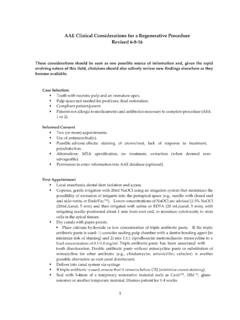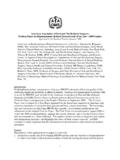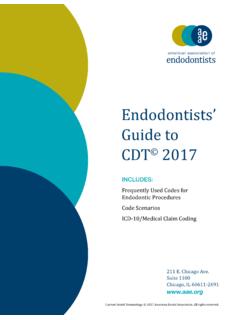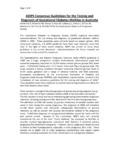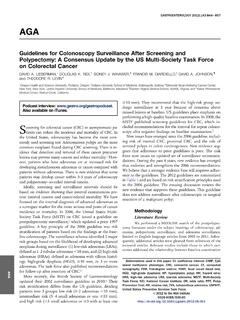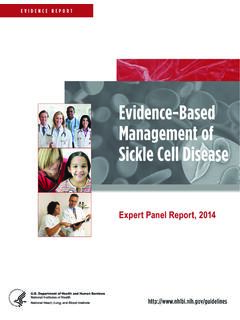Transcription of AAE Guidance on Antibiotic Prophylaxis for Patients at ...
1 AAE Guidance on Antibiotic Prophylaxis for Patients at Risk of Systemic Disease | Page 1 Antibiotic Prophylaxis (AP) refers to the practice of the administration of antibiotics to Patients without signs of infection in order to reduce subsequent postoperative or post-treatment complications by the prevention of bacterial colonization. In dentistry, the main indications for Antibiotic Prophylaxis have been to prevent infective endocarditis (IE) and prosthetic joint implant infection (PJI). Patients at risk of infective endocarditisInfective endocarditis (IE) is an infection caused by pathogens that enter the bloodstream and settle in the heart lining, one or more heart valves or blood vessels. Patients with certain predisposing conditions may have a greater risk of developing IE. In the past, Patients with nearly every type of congenital heart defect received antibiotics before dental procedures based on recommendations by the American Heart Association (AHA). For non-penicillin allergic Patients , oral penicillin was recommended from 1955 until 1990.
2 In 1990, 3g amoxicillin became the oral regimen of choice, to be taken one hour before dental procedures (1). In 1997 the recommended amoxicillin dose was reduced to 2g (2).In 2007, the AHA developed revised guidelines by using an evidence-based approach to reduce ambiguities about the patient for whom AP may be indicated and under what conditions, as well as what antibiotics to use (3). The Council on Scientific Affairs of the American Dental Association (ADA) approved these guidelines, which were also published in the association s dental journal (4). The major change was that antibiotics prior to dental procedures would only be recommended for Patients with underlying cardiac conditions associated with the highest risk of adverse outcome from IE. The following cardiac conditions for which AP with dental procedures would be reasonable were identified as: Prosthetic cardiac valve or prosthetic material used for cardiac valve repair Previous infective endocarditis Congenital heart disease (CHD) Unrepaired cyanotic CHD, including palliative shunts and conduits Completely repaired congenital heart defect with prosthetic material or device, whether placed by surgery or by catheter intervention, during the first six months after the procedureDistribution InformationAAE members may reprint this position statement for distribution to Patients or referring AE Guidance on Antibiotic Prophylaxis for Patients at Risk of Systemic DiseaseThe Guidance in this statement is not intended to substitute for a clinician s independent judgment in light of the conditions and needs of a specific This DocumentThis paper is designed to provide scientifically based Guidance to clinicians regarding the use of antibiotics in endodontic treatment.
3 Thank you to the Special Committee on Antibiotic Use in Endodontics: Ashraf F. Fouad, Chair, B. Ellen Byrne, Anibal R. Diogenes, Christine M. Sedgley and Bruce Y. Cha. 2017 Access additional resources at Repaired CHD with residual defects at the site or adjacent to the site of a prosthetic patch or prosthetic device (which inhibit endothelialization) Cardiac transplantation recipients who develop cardiac valvulopathyIn 2017, the AHA and American College of Cardiology (ACC) published a focused update (5) to their previous guidelines on the management of valvular heart disease. This reinforced their previous recommendations that AP is reasonable for the subset of Patients at increased risk of developing IE and at high risk of experiencing adverse outcomes from IE (5). Their key recommendations were: Prophylaxis against IE is reasonable before dental procedures that involve manipulation of gingival tissue, manipulation of the periapical region of teeth, or perforation of the oral mucosa in Patients with the following:1.
4 Prosthetic cardiac valves, including transcatheter-implanted prostheses and homografts. 2. Prosthetic material used for cardiac valve repair, such as annuloplasty rings and Previous Unrepaired cyanotic congenital heart disease or repaired congenital heart disease, with residual shunts or valvular regurgitation at the site of or adjacent to the site of a prosthetic patch or prosthetic Cardiac transplant with valve regurgitation due to a structurally abnormal valve. The 2017 AHA/ACC report also noted that, based on limited data, IE appears to be more common in heart transplant recipients than in the general population; the risk of IE is highest in the first six months after transplant because of endothelial disruption, high-intensity immunosuppressive therapy, frequent central venous catheter access, and frequent endomyocardial biopsies (5).Elsewhere, concerns about overprescribing AP have also received attention. In Europe, similar guidelines to those in the restricting AP to only Patients with the highest risk of IE were issued in 2009 (6).
5 In contrast, complete restrictions were placed in the United Kingdom (UK) in 2008, the recommendation being: Antibiotic Prophylaxis against infective endocarditis is not recommended for people undergoing dental procedures (7).The National Institute for Health and Clinical Excellence (NICE) in the UK based their rationale for total AP restriction on the absence of randomized controlled trials assessing the efficacy of AP for the prevention of IE, the existence of doubts about the relative importance of dental procedures as a cause of IE compared with other portals of entry or low-grade recurrent bacteremia occurring in the course of daily life, and the overall hazards of Antibiotic use (particularly anaphylaxis and the development of Antibiotic resistance) (8). It should be noted, that a 2015 retrospective secular trend, interrupted time series study of a large dataset in England reported that the incidence of infective endocarditis had increased significantly in England since introduction of the 2008 NICE guidelines (9).
6 While the increase in incidence of IE was significant both for individuals at high risk of infective endocarditis and those at lower risk, the authors noted that their data do not establish a causal association . NICE guidelines were revised to: Antibiotic Prophylaxis against infective endocarditis is not recommended routinely for people undergoing dental procedures (10).A recurring theme in the relevant literature is that there is an absence of robust data about the effectiveness of AP to prevent IE. A systematic review and meta-analysis published in 2017 concluded: the evidence base for the use of AP is limited, heterogeneous and the methodological quality of many studies is poor. Post-procedural bacteremia is not a good surrogate endpoint for IE. Given the logistical challenges of a randomized trial, high quality case control studies would help to evaluate the role of dental procedures in causing IE and the efficacy of AP in its prevention (8). As part of its Oral Health Topic series in March 2017 (20), the ADA recommended that dental professionals continue to follow the AHA guidelines (3, 4), including the dosage regimens for a dental procedure reflected in the 2008 AAE Quick Reference Guide as follows:AAE Guidance on Antibiotic Prophylaxis for Patients at Risk of Systemic Disease | Page 3 Regimen: Single Dose 30 to 60 min.
7 Before ProcedureSituationAgentAdultsChildrenOra lAmoxicillin2 g50 mg/kgUnable to take oral medicationAmpicillinORCefazolin or ceftriaxone2 g IM* or IV+1 g IM or IV50 mg/kg IM or IV50 mg/kg IM or IVAllergic to penicillins or ampicillin oralCephalexin ORClindamycinORAzithromycin or clarithromycin2 g600 mg500 mg50 mg/kg20 mg/kg15 mg/kgAllergic to penicillins or ampicillin and unable to take oral medicationCefazolin or ceftriaxone ORClindamycin1 g IM or IV600 mg IM or IV50 mg/kg IM or IV20 mg/kg IM or IV*IM: Intramuscular+IV: Intravenous Or other first- or second-generation oral cephalosporin in equivalent adult or pediatric dosage. Cephalosporins should not be used in an individual with a history of anaphylaxis, angioedeme, or urticaria with penecillins or for a Dental Procedure**Source: ADA Division of Legal Affairs, An Updated Perspective of Antibiotic Prophylaxis , Journal of American Dental Association. 2008; 139:10-21 The 2007 guidelines state that an Antibiotic for Prophylaxis should be administered in a single dose before the procedure (3, 4).
8 However, special circumstances can arise in clinical practice. For example, in the event that the dosage of Antibiotic is inadvertently not administered before the procedure, it may be administered for up to 2 hours after the procedure. For Patients already receiving an Antibiotic that is also recommended for IE Prophylaxis , then a drug should be selected from a different class. For example, a patient already taking oral penicillin for other purposes may likely have in their oral cavity viridans group streptococci that are relatively resistant to beta-lactams. In these situations, clindamycin, azithromycin or clarithromycin would be recommended for AP. Alternatively, if possible, treatment should be delayed until at least 10 days after completion of the Antibiotic to allow re-establishment of usual oral flora. In situations where Patients are receiving long-term parenteral Antibiotic for IE, the treatment should be timed to occur 30 to 60 min after delivery of the parenteral Antibiotic .
9 It is considered that parenteral antimicrobial therapy is administered in such high doses that the high concentration would overcome any possible low-level resistance developed among oral flora (3, 4). Patients at risk of prosthetic joint implant infectionPatients with prosthetic joints have been considered to be at increased risk of developing PJI subsequent to receiving dental care. Since 1997, several advisory statements or clinical practice guidelines have been published by the ADA and/or the American Academy of Orthopaedic Surgeons (AAOS) to address AP to prevent PJI (11-17). In 2009, the AAOS released an information statement regarding AP for dental Patients with total joint replacements recommending that clinicians consider AP for all total joint replacement Patients prior to any invasive procedure that may cause bacteremia (16). The 2009 information statement generated considerable controversy and confusion (18, 19). In 2012, the AAOS/ADA jointly released revised clinical practice guidelines for AP for Patients with PJIs based on a comprehensive analysis of the available literature by a physician and dentist volunteer work group and experts in systematic reviews; the final review was further subjected to peer review by several independent organizations (15).
10 These guidelines were summarized as follows: 1. The practitioner might consider discontinuing the practice of routinely prescribing prophylactic antibiotics for Patients with hip and knee prosthetic joint implants undergoing dental procedures. Grade of Recommendation: Limited Definition: A Limited recommendation means the quality of the supporting evidence that exists is unconvincing, or that well-conducted studies show little clear advantage to one approach versus another. Implications: Practitioners should be cautious in deciding whether to follow a recommendation classified as Limited, and should exercise judgment and be alert to emerging publications that report evidence. Patient preference should have a substantial influencing role. Access additional resources at We are unable to recommend for or against the use of topical oral antimicrobials in Patients with prosthetic joint implants or other orthopaedic implants undergoing dental procedures. Grade of Recommendation: Inconclusive Definition: An Inconclusive recommendation means that there is a lack of compelling evidence resulting in an unclear balance between benefits and potential harm.



